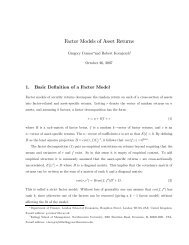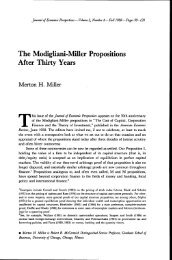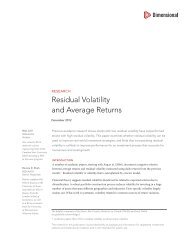Campbell, John Y, Jens Hilscher and Jan Szilagyi, 2005.
Campbell, John Y, Jens Hilscher and Jan Szilagyi, 2005.
Campbell, John Y, Jens Hilscher and Jan Szilagyi, 2005.
Create successful ePaper yourself
Turn your PDF publications into a flip-book with our unique Google optimized e-Paper software.
legeist, Keating, Cram, <strong>and</strong> Lunstedt (2004) by solving a system of two nonlinearequations. The details of the calculation are described in the Appendix. Table 5compares the predictive power of the structural model with that of our best reducedformmodel. The top panel reports the coefficients on DD in a simple regression ofour failure indicator on DD, <strong>and</strong> in a multiple regression on DD <strong>and</strong> the variablesincluded in our reduced-form model. DD enters with the expected negative sign <strong>and</strong>is highly significant in the simple regression. In the multiple regression, however,it enters with a perverse positive sign at a short horizon, presumably because thereduced-form model already includes volatility <strong>and</strong> leverage, which are the two maininputs to the calculation of DD. The coefficient on DD only becomes negative <strong>and</strong>significant when the horizon is extended to one or three years.ThebottompanelofTable5reportsthepseudoR 2 statistics for these regressions.While the structural model achieves a respectable R 2 of 16% for short-term failureprediction, our reduced-form model almost doubles this number. Adding DD to thereduced-form model has very little effect on the R 2 , which is to be expected giventhe presence of volatility <strong>and</strong> leverage in the reduced-form model. These results holdboth when we calculate R 2 in-sample, using coefficients estimated over the entireperiod 1963-2003, <strong>and</strong> when we calculate it out-of-sample, using coefficients eachyear from 1981 onwards that were estimated over the period up to but not includingthat year. The two sets of R 2 are very similar because most failures occur towardsthe end of the dataset, when the full-sample model <strong>and</strong> the rolling model have verysimilar coefficients.The structural approach is designed to forecast default at a horizon of one year.This suggests that it might perform relatively better as we forecast failure furtherinto the future. It is true that DD enters our model significantly with the correctsign at longer horizons, but Table 5 shows that the relative performance of DD <strong>and</strong>our econometric model is relatively constant across forecast horizons.We conclude that the structural approach captures important aspects of theprocess determining corporate failure. The predictive power of DD is quite impressivegiven the tight restrictions on functional form imposed by the Merton model. Ifone’s goal is to predict failures, however, it is clearly better to use a reduced-formeconometric approach that allows volatility <strong>and</strong> leverage to enter with free coefficients<strong>and</strong> that includes other relevant variables. Bharath <strong>and</strong> Shumway (2004), inindependent recent work, reach a similar conclusion.15





